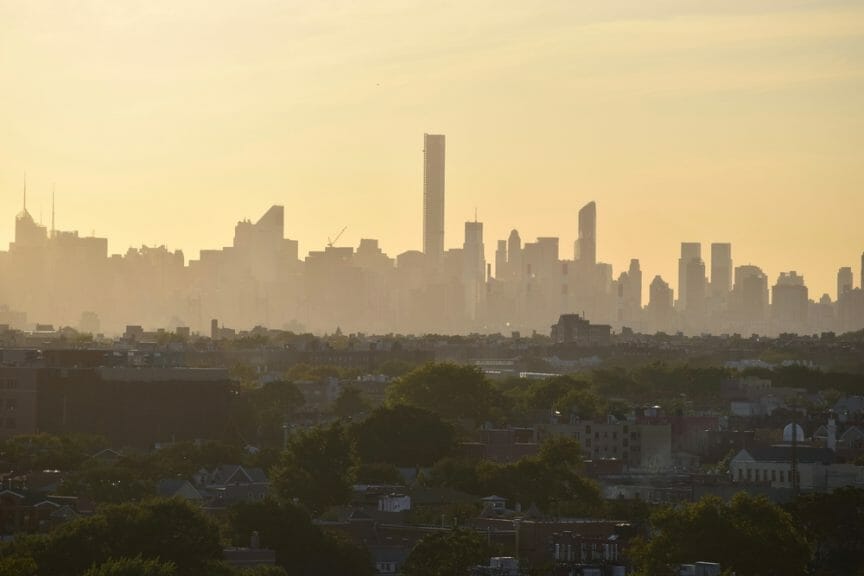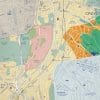The city of New York found itself at the top of the list for the world’s worst air pollution on Tuesday as smoke from over a hundred wildfires burning in Quebec, Canada, drifted southward. The smoke has been intermittently affecting the Northeast and Mid-Atlantic regions for more than a week, raising concerns about persistent poor air quality and its detrimental effects.
At one point on Tuesday night, New York City’s air quality index exceeded 200, classified as “very unhealthy” by IQair. This made it the city with the worst air quality among major metropolitan areas. Later that night, New York City ranked second in the world for air pollution, surpassed only by New Delhi, India. Other cities on the list included Doha, Qatar; Baghdad, Iraq; and Lahore, Pakistan.
The elevated levels of air pollution led to the cancellation of outdoor activities and events in at least 10 school districts in central New York state. School announcements stated that academic, athletic, and extracurricular events were canceled, and outdoor recess and gym classes were also affected.
Wildfire smoke contains fine particulate matter known as PM2.5, which is the most dangerous pollutant due to its small size. When inhaled, PM2.5 can penetrate deep into lung tissue and enter the bloodstream, leading to various health issues such as asthma, heart disease, and respiratory illnesses. Air pollution-related health problems result in millions of premature deaths worldwide each year.
On Tuesday, the concentration of PM2.5 in New York City’s air was more than 10 times the guideline set by the World Health Organization. It is crucial for individuals to be aware of their exposure to smoke, remain indoors during episodes of high pollution, and monitor their health for any symptoms or worsening conditions.
The wildfires in Quebec have been particularly severe, with over 150 active fires burning in the region. This surpasses the number of fires burning in any other Canadian province. So far in 2023, nearly 9 million acres have been affected by wildfires in Canada, with Quebec alone accounting for nearly half a million acres.
The impact of the smoke is not limited to New York City. Air quality alerts were issued for parts of the Northeast and Midwest as the smoke spread westward, reaching cities like Detroit and Chicago. The National Weather Service advised individuals, especially those with respiratory diseases like asthma, to limit prolonged outdoor activity.
The persisting issue of wildfires and their associated smoke is closely linked to human-caused climate change. The hotter and drier conditions resulting from climate change contribute to the ignition and spread of wildfires. Carbon pollution from the largest fossil fuel and cement companies has been identified as a significant factor in the scorching of millions of acres in the Western US and Canada.
The smoke generated by wildfires can travel long distances, endangering millions of people. The severity of the situation highlights the global impact of climate change and the urgent need to address it.
The ongoing issue of wildfires and their far-reaching smoke underscores the urgent need for action to mitigate and adapt to climate change. Human-caused global warming has created the conditions conducive to more frequent and intense wildfires, posing significant threats to air quality and public health.
The harmful effects of wildfire smoke extend beyond immediate health concerns. It also exacerbates existing health disparities, as vulnerable populations, including children, the elderly, pregnant individuals, and those with respiratory or cardiovascular diseases, are more susceptible to its impacts. Disruptions to daily life, such as the cancellation of outdoor activities and events, further highlight the pervasive influence of wildfires on communities.
Efforts to combat climate change and reduce the risk of devastating wildfires require a comprehensive approach. This includes transitioning to cleaner and renewable sources of energy, implementing sustainable land management practices, and fostering international cooperation to address the global nature of the problem.
Local and regional initiatives are crucial in improving air quality and protecting public health during wildfire events. Timely air quality alerts, effective communication strategies, and support for vulnerable populations can help mitigate the adverse impacts of smoke exposure. Investing in early warning systems, advanced monitoring technologies, and emergency response capabilities can enhance preparedness and response efforts.
In addition to addressing the root causes of wildfires, society must also focus on adapting to the changing climate. This involves incorporating resilience measures into urban planning, designing buildings with improved indoor air quality systems, and implementing public health strategies to minimize the health risks associated with prolonged exposure to smoke.
Education and public awareness are vital components of addressing the interconnected challenges of climate change, wildfires, and air pollution. Raising awareness about the consequences of carbon emissions, advocating for sustainable practices, and promoting community engagement can foster a collective commitment to environmental stewardship and encourage individual actions to mitigate climate change.
Ultimately, effective solutions require global cooperation and commitment. Governments, businesses, and individuals must work together to reduce greenhouse gas emissions, protect vulnerable communities, and build a sustainable and resilient future. By taking decisive action, we can strive for cleaner air, healthier environments, and a more sustainable planet for generations to come.














